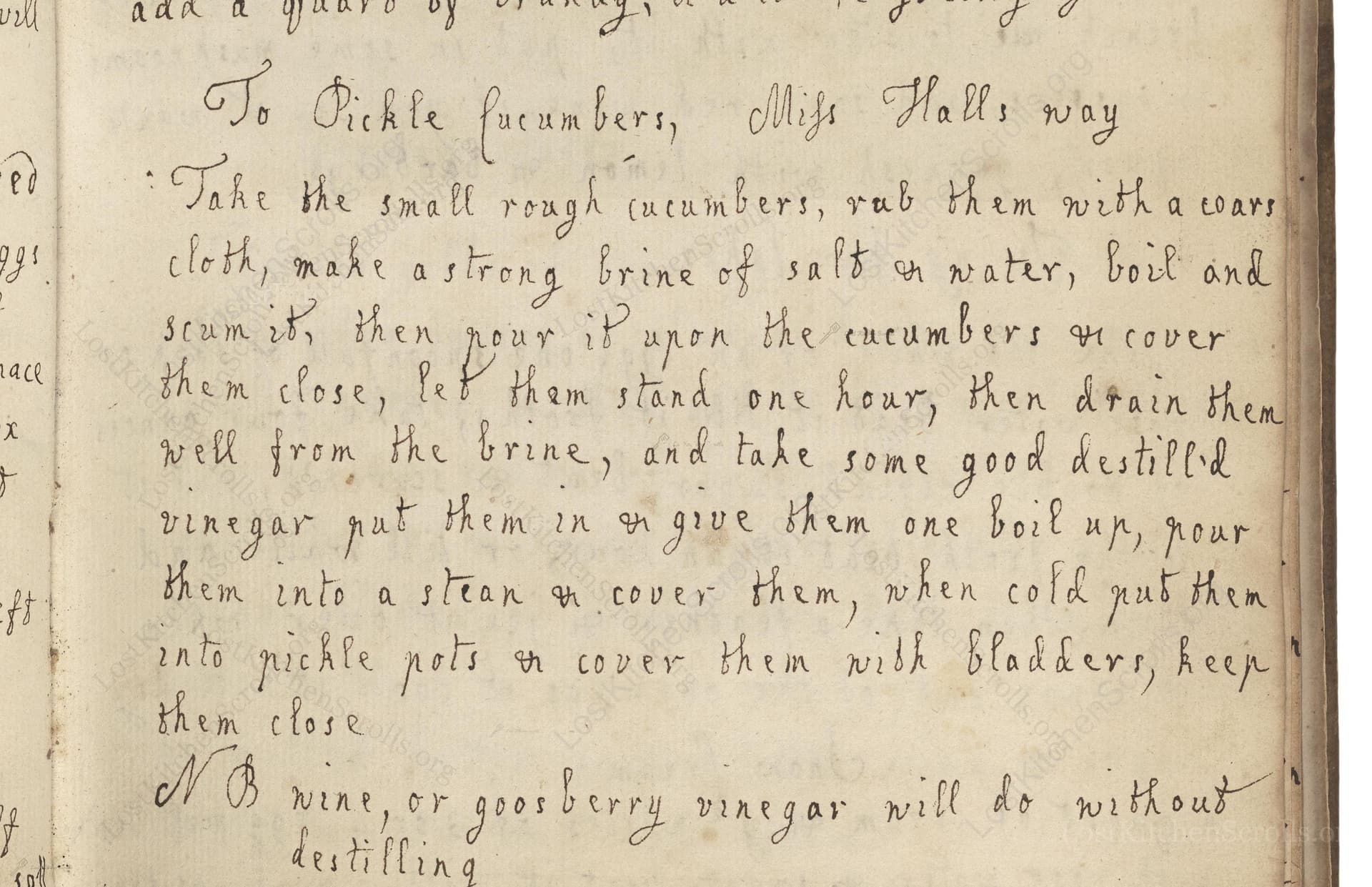To Pickle Cucumbers, Miss Halls Way
From the treasured pages of Cookbook of 1720
Unknown Author

To Pickle Cucumbers, Miss Halls Way
"Take the small rough cucumbers, rub them with a coars cloth, make a strong brine of salt or water, boil and scum it, then pour it upon the cucumbers & cover them close, let them stand one hour, then drain them well from the brine, and take some good destill'd vinegar put them in & give them one boil up, pour them into a stean & cover them, when cold put them into pickle pots & cover them with bladders, keep them close NB wine, or goosberry vinegar will do without destilling"
Note on the Original Text
The recipe is written in the practical, flexible style typical of 18th-century household manuscripts. Measurements are imprecise, trusting the cook's intuition and experience, while instructions focus on the sequence of processes rather than precise timing or temperatures. Spelling and capitalization are irregular but intelligible—'scum' for 'skim,' 'stean' likely for 'stewpan' or 'colander,' and 'bladders' to seal the pots, a practice now obsolete. The reference to 'wine, or goosberry vinegar will do without destilling' is advice for flexibility, enabling the preservation of cucumbers using naturally-fermented or homemade vinegars in place of commercially-distilled ones.

Title
Cookbook of 1720 (1720)
You can also click the book image above to peruse the original tome
Writer
Unknown
Era
1720
Publisher
Unknown
Background
Step back to the early 18th century and discover a delightful treasury of recipes and culinary secrets, where traditional flavors meet timeless technique—a feast for curious cooks and history lovers alike.
Kindly made available by
Folger Shakespeare Library
This pickling recipe hails from early 18th-century England, around 1720—a time when preserving vegetables was a vital skill due to lack of refrigeration. The method reflects a period where both salt-based brining and the growing popularity of vinegar were employed to extend the shelf life of seasonal produce. The recipe's connection with a 'Miss Hall' indicates the domestic, often female-driven, culinary tradition of manuscript cookbooks, where households curated their own collections of tried-and-true recipes. Interestingly, the mention of gooseberry vinegar and wine vinegar as alternatives hints at the inventive spirit in the kitchen—making do with what was at hand.

Historically, the essential tools included a coarse linen cloth for cleaning cucumbers, a large iron or earthenware pot for boiling the brine, and wooden or stoneware pickle pots for storage. Tightly stretched animal bladders were employed as air barriers to seal jars, as glass and screw-top lids were not yet common. The boiling and scumming required a ladle or spoon, likely made from wood or pewter.
Prep Time
15 mins
Cook Time
10 mins
Servings
6
We've done our best to adapt this historical recipe for modern kitchens, but some details may still need refinement. We warmly welcome feedback from fellow cooks and culinary historians — your insights support the entire community!
Ingredients
- 1 lb small pickling cucumbers (gherkins or cornichons)
- 3.5 oz salt (for 1 qt water)
- 1 qt water
- 3 cups distilled white vinegar (or white wine vinegar or gooseberry vinegar, if available)
- Optional: cling film or jar lids (historically, animal bladders were used for sealing)
Instructions
- Begin with small, bumpy pickling cucumbers (cornichon or gherkin type is ideal).
- Gently rub off any dirt using a coarse clean cloth.
- Prepare a strong brine by dissolving about 3.5 ounces of salt per quart of water.
- Bring the brine to a boil and skim off any foam that rises to the surface.
- Pour the hot brine over the cucumbers, cover, and let them sit for one hour.
- After an hour, drain the cucumbers and discard the brine.
- In a large pot, bring enough good-quality distilled white vinegar to a boil—enough to cover your cucumbers.
- Add the cucumbers and bring them just quickly to a boil once more.
- Transfer everything into a clean colander or bowl, cover, and let cool.
- Upon cooling, move the cucumbers to sterilized jars or pots, pour over enough vinegar to fully submerge, and seal well (cling film or a tight jar lid works instead of a bladder).
- Store in a cool, dark place.
Estimated Calories
15 per serving
Cooking Estimates
Preparing the cucumbers, making the brine, and boiling the vinegar take most of the time. You only need a few minutes for each step, but resting and cooling add extra time. This doesn't require a lot of active cooking.
As noted above, we have made our best effort to translate and adapt this historical recipe for modern kitchens, taking into account ingredients nowadays, cooking techniques, measurements, and so on. However, historical recipes often contain assumptions that require interpretation.
We'd love for anyone to help improve these adaptations. Community contributions are highly welcome. If you have suggestions, corrections, or cooking tips based on your experience with this recipe, please share them below.
Join the Discussion
Rate This Recipe
Dietary Preference
Main Ingredients
Culinary Technique
Occasions

Den Bockfisch In Einer Fleisch Suppen Zu Kochen
This recipe hails from a German manuscript cookbook compiled in 1696, a time whe...

Die Grieß Nudlen Zumachen
This recipe comes from a rather mysterious manuscript cookbook, penned anonymous...

Ein Boudain
This recipe comes from an anonymous German-language manuscript cookbook from 169...

Ein Gesaltzen Citroni
This recipe, dating from 1696, comes from an extensive anonymous German cookbook...
Browse our complete collection of time-honored recipes



